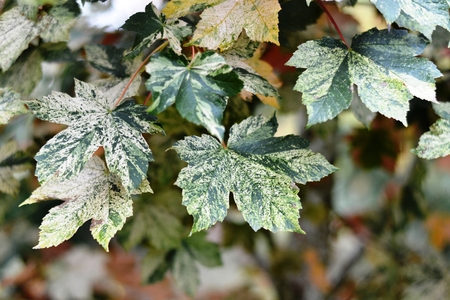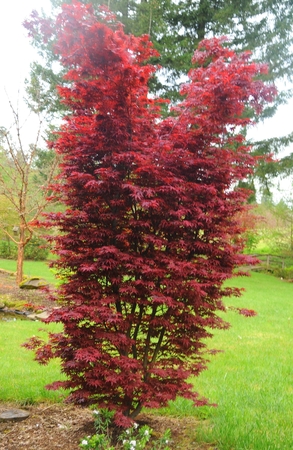Pickup Only 2020 — 05/15/2020
May, 2020
Dear Friends,
Seems like early April was ages ago, given the constant drumbeat of negative news on the virus and unemployment numbers. So we want to give you a detailed update from Heritage …
Here, we insist that each staff member:
- Wash hands before leaving home
- Wear mask when commuting to work - if more than 1 per vehicle
- Wash hands when arriving on nursery property
- Before starting work, meet with supervisors to review work and how to maintain separation, wear PPE
- Keep 6-feet separation within small workgroups; clear poly barriers on transplanters where 6-foot separation is not possible
- Records all whom he/she encounters daily
- Wear masks all day when not eating or drinking; breaks not in communal areas with more than several crew in proximity
- Wash hands frequently, at least every break and lunch period
- Sanitize all common-use areas- lunch and bathroom facilities; doors, equipment handles, buttons, knobs, steering wheels
- Wash hands before departing work for home; masks mandatory on commute home
The same small workgroups work together daily. This facilitates tracing if someone becomes ill. So far, we’ve found these measures effective. We continue otherwise normal operations.
The good news:
- We were initially anxious that we might have a rash of slow-pays, but accounts receivable - no problems at all.
- Our sense is that among almost all in the trade, the mood is cautiously optimistic.
- A surprising number of our customers are ordering already for fall, verifying that we’ll have product for them, securing their needs early to be assured of that. Generally these are our larger clients.
- The nursery business seems to have benefited from people staying home, fixing up the house, gardening, and doing long-put-off maintenance around the house. That’s true at our own home, where Jolly and I spend more time communicating with managers by email and phone. Our garden has never looked so well kept and we’ve planted dozens of our newer varieties around the house. Mark and Jolly are more involved with managers than ever, investing in constant improvements, new variety development, and report analyses with key managers.
- The company is in very capable hands, even if we are out for weeks at a time. Our managers work collaboratively in a very tight-knit communication culture and appreciate each other’s unique skill set and clear areas of management authority.

We want to reassure you that we are all-in this season, transplanting a record number of liners from plugs and smaller liners from last year’s crop so you’ll have a plentiful supply of items in several sizes. We’ve continued to replace outdated equipment, renovate our entire softwood cutting bench operation, irrigators in greenhouses, nozzles and valves in hoops, and keeping up with sanitary measures so you don’t get weeds or pests with our product. We’re upgrading staff training all the time and feel we now have our best group of managers and crew ever. Moreover, we have brought back more than a hundred items that we used to grow, but dropped in recent years due to limited sales. We’ll offer these “Connoisseur Plants” in limited quantities of 750 to 1,500 each. So look for that list later this summer and get your order in early for any that jump off the page. We’ll introduce quite a few new plants of our own selection in the seasons to come – columnar forms or unique items that have no trade equivalent.
This is an exciting place to work. We appreciate our staff and our customers; we love the plants, and Oregon is the perfect environment for us to operate. So even in more isolated circumstances now, we find ourselves looking up occasionally and musing, “Does life get better than this?” Maybe. We all work for that prospect. So we count our many blessings, thank our staff daily, thank you for your trust and your business, and wish each of you well.
What can we do for YOU? Peruse this list and let us know. Call or write, and book your order for fall or next spring. We’ll keep you updated via email, our website, and phone.
Kind regards,
Mark, Jolly & Staff

January Focus Plants — 01/06/2020
Acer palmatum 'Twombly's Red Sentinel'
This Ken Twombly introduction has a unique narrow upright shape, attractive in many situations where space is limited, particularly close to a building or walkway. Plants in our landscape are more appealing with each passing season. It remains a strong maroon color all summer long here in NW Oregon.

Acer pseudoplatanus 'Esk Sunset'
"Variegated" doesn't begin to describe this extraordinary cultivar of a species that generally lacks ornamental merit. In addition to the leaves being purple beneath, they're a kaleidoscope of astonishing variegation throughout. It doesn't burn in full sun, and is exceptionally drought resistant and cold hardy. Whether placed as an accent against larger, darker trees, or as a specimen up front, it will elicit comments from all who enjoy seeing it for the first time. This goes on your 'buy list'. Make sure of it, OK? You'll be back for more.

Nursery Media - Air in your mix...what's the big deal? — 01/29/2018View Details
Growers pay close attention to water and fertilizer. And we know that woody ornamental roots require a well-aerated growing mix - at least 20% free air space - to get enough oxygen to promote healthy growthand prevent disease. Yet, how often do growers neglect to seasonally monitor their mix for its porosity –its free air space after irrigation?
If you need to verify the porosity of your own mix, try this easy method. Keep detailed records for various crops, start to finish:
1. Choose several potted plants from a block to test. Tape over the pot drainage holes.
2. Carefully add water to each pot until you just begin to see it at the top of the container mix.
3. Without tilting the pot, remove the tape to catch the draining water for a minute or so.
4. Accurately determine the cc or ml volume of water using a small measuring cup.
5. Using the cm scale on your tape measure, determine your pot dimensions to calculate soil mix cc volume. Formula: πr 2 h (3.14 x average radius squared x mix height) for roughly cylindrical pots like a #1 or #3. For conical pots, the formula is the same, but divide result by 3.
6. Divide the collected cc’s of water by total soil cc volume. Multiply decimal result by 100 to get your percentage of unfilled pore space in the mix. (Air replaces all the water you collect.)
Consider how important AIR is to your potted woody profit experience…
What’s your test result? Most woodies grow best in a potting mix of 20-30% porosity. Root expansion and mix decomposition diminish free air space throughout the growing season, so a mix may test 27% to start, but by season’s end it may decline to 12-15%. If your mix tests below 22-24% from the get-go, consider using a more coarse mix, even if you just cautiously set up a significant side-by-side contrast trial. You’ll be glad you did.
Untrained crews may press down a mix too tightly at potting time. Stacking on a pallet after filling flats – it’s a poor handling practice if your potting mix gets compressed. Summer heat tends to subside after mid-late August. But unless trained otherwise, irrigation staff may complacently rely on irrigation timers instead of lifting pots and flats – using experienced judgment before cranking on the water.
How often do supervisors get riled up if a crew person lets a block of plants dry out too much, but if that same person over-irrigates, hardly anyone notices? In so doing, do supervisors effectively train irrigation crews to drown plants?
Watering crews have your checkbook in their hands. Over-watering containers - not
allowing them to dry down during the irrigation cycle - means a mix has less time with the minimum air needed to support vigorous, healthy roots. Phytopthora and other root infections may develop, getting progressively worse before they’re apparent.
These practices all foster inadequate soil mix porosity - conditions ripe for root disease and failure - literally at the finish line. What changes might you make in your operation if this provokes your concern? How may we help you with more information?
An excellent mix in our propagation experience is 75% coarse bark, no more than 10% coarse peat, and 15% perlite or pumice. You may wish to evaluate 90% coarse bark + 10% coarse peat. Baled bedding plant mixes, used for vegetable starts and plugs, are too expensive to use in large pots. But with thoughtful irrigation practice, as long as you incorporate slow-release fertilizer and include calcium, magnesium and micro-nutrients, even a pure bark container medium can grow healthy woody plants you’d be proud to offer.
At Heritage, we regularly evaluate our growing media for porosity, EC (soluble fertilizer level) and moisture. Simple methods - using a salt meter, lifting plug trays or pots to judge their moisture level – are easy but critical staff training elements. We closely monitor root development so we send you nothing but the most healthy, white-rooted woody liners at the end of the season.
We offer these ideas to help you profit with our plants, so they will grow up like healthy kids and make us all proud. It’s just a tangible, specific example of how Heritage is distinctively different. We aren’t just your supplier; we’re your growing partner.


